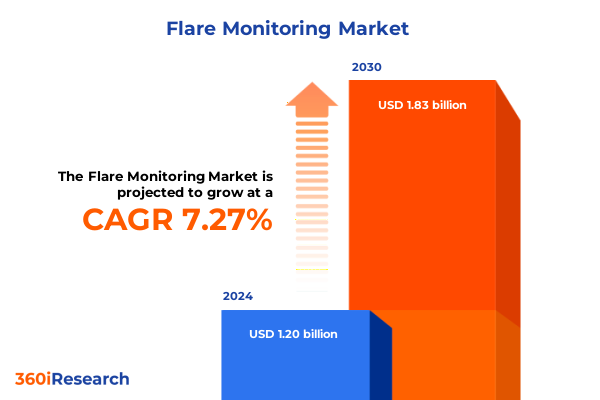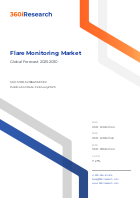The Flare Monitoring Market size was estimated at USD 1.20 billion in 2024 and expected to reach USD 1.29 billion in 2025, at a CAGR 7.27% to reach USD 1.83 billion by 2030.

Introduction: Navigating the Evolving Flare Monitoring Market
In an era defined by stringent emissions standards and the growing imperative for environmental stewardship, flare monitoring has emerged as a critical discipline for energy and chemical producers. Advanced monitoring solutions not only ensure regulatory compliance but also enhance operational safety, minimize waste, and unlock cost efficiencies. For decision-makers and technical experts alike, understanding the intricacies of flare systems-ranging from hardware sensors to predictive analytics-has become pivotal to maintaining competitiveness and resilience. This executive summary distills the latest trends, tariff impacts, segmentation dynamics, regional hotspots, and leadership strategies shaping the set of technologies and services dedicated to real-time flare management. By tracing the transformative shifts in market drivers and synthesizing insights across segments, regions, and top innovators, we equip stakeholders with a concise, authoritative overview enabling swift, informed action. The following sections proceed logically from the macro forces at play to granular recommendations, culminating in a clear path for securing a comprehensive market research report.
Transformative Shifts Reshaping Flare Monitoring Dynamics
The landscape of flare monitoring is undergoing a paradigm shift fueled by digital transformation, regulatory tightening and growing investor scrutiny around environmental performance. Historically, operators relied on periodic manual checks and basic hardware devices. Today, real-time monitoring platforms integrate high-resolution sensors with edge and cloud computing, enabling continuous data capture and predictive maintenance. Artificial intelligence algorithms now flag anomalies before they escalate into safety incidents or regulatory fines. Meanwhile, the proliferation of wireless communication technologies has extended monitoring capabilities into remote and offshore environments. Concurrently, public disclosure demands are driving transparency in emissions reporting, prompting companies to adopt comprehensive monitoring strategies. The convergence of low-cost sensor networks, robust analytics software and service-oriented models is redefining value propositions across the industry. As a result, flare monitoring is shifting from a compliance exercise to a strategic asset that can optimize operational performance, reduce carbon footprint and unlock new revenue streams through improved reliability and reduced unplanned flaring.
Assessing the Cumulative Impact of US Tariffs in 2025
The United States’ decision to impose additional tariffs on imported flare monitoring components in 2025 is poised to create ripple effects across the global supply chain. Hardware sourced from key international manufacturers, including communication devices, controllers and specialized sensors, will see cost increases that ultimately translate into higher system prices for end-users. Service providers reliant on imported calibration instruments and maintenance tools face margin pressure, potentially slowing project deployment. At the same time, software vendors that license predictive analytics engines may experience indirect impacts as clients reassess capital budgets. Domestic producers could gain market share, yet they will need to ramp up capacity rapidly and invest in advanced manufacturing to meet rising demand. The tariff landscape also accelerates initiatives to localize supply chains and develop alternative low-cost components. Overall, while near-term project costs are expected to rise, the policy shift may spur long-term innovation and resilience in domestic flare monitoring capabilities.
Key Segmentation Insights Driving Tailored Solutions
Dissecting the market through multiple lenses reveals nuanced opportunities and challenges. When viewed by technology, hardware stands out with its communication devices, controllers and diverse sensor types forming the backbone of any monitoring solution, while services encompass consultancy, installation and ongoing support, and software spans predictive analytics and real-time monitoring platforms. Examining component classification, the core flare stack system-comprising flare tips and ignition mechanisms-interfaces with measurement subsystems like gas flow meters, pressure gauges and temperature probes. In industry terms, demand originates from chemical producers of both inorganic and organic compounds, oil and gas operators across upstream and downstream segments, and petrochemical plants focused on aromatics and olefins production. From an end-user perspective, chemical plants, offshore platforms and refineries each exhibit distinct performance criteria. Application categories distinguish offshore deepwater and subsea monitoring from onshore gas wells and oil fields, as well as remote monitoring frameworks. Monitoring types vary between continuous online systems, scheduled-interval intermittent methods and handheld portable devices. Finally, system deployment models range from built-in fixed installations to truck-mounted mobile units and short-term rental setups.
This comprehensive research report categorizes the Flare Monitoring market into clearly defined segments, providing a detailed analysis of emerging trends and precise revenue forecasts to support strategic decision-making.
- Technology
- Component
- Industry
- End-User
- Application
- Type
- System
Key Regional Insights Spotlighting Growth Hotspots
Geographic trends underscore where investment and regulatory pressures converge. In the Americas, stringent environmental regulations in the United States and Canada, coupled with robust capital markets, underwrite rapid adoption of advanced monitoring platforms, particularly among shale gas operators. Europe, the Middle East and Africa display a heterogeneous mix: Europe leads in stringent CO₂ reporting requirements and incentives for emissions reduction technologies, the Middle East leverages monitoring to optimize massive downstream complexes, and African nations increasingly seek cost-effective solutions for aging infrastructure. Asia-Pacific emerges as the fastest-growing region, driven by China’s industrial upgrade policy, Southeast Asia’s expanding petrochemical base and Australia’s offshore gas developments. Regional innovation clusters are also forming, with local manufacturers and service providers adapting global technologies to meet unique regulatory frameworks and climatic challenges.
This comprehensive research report examines key regions that drive the evolution of the Flare Monitoring market, offering deep insights into regional trends, growth factors, and industry developments that are influencing market performance.
- Americas
- Asia-Pacific
- Europe, Middle East & Africa
Key Company Insights Shaping Market Innovation
A diverse roster of market leaders and innovators shapes the competitive landscape. Global industrial giants such as ABB Ltd. and Siemens AG deploy integrated hardware and software ecosystems, while Emerson Electric Co. and Honeywell International, Inc. leverage decades of process automation expertise to enhance flare monitoring solutions. Niche technology providers like INFRARED CAMERAS INC. and Viper Imaging, LLC specialize in optical gas imaging tools that complement existing sensor networks. Precision instrument manufacturers-AMETEK, Inc., Sage Metering, Inc. and Darcy Partners, LLC-deliver high-accuracy flow and pressure measurement systems. Service-oriented firms such as Lakeside Process Controls, Ltd. and Southland Sensing Ltd. provide localized calibration, installation and maintenance expertise. Emerging specialists-including PROVENCE Photonics, LLC, Kinetics Technology Corporation and Zubair Oil & Gas LLC-push the boundaries of remote and portable monitoring. Meanwhile, spectrum of solutions spans from portable handheld devices by Teledyne FLIR LLC, Tempsens Instrument Pvt. Ltd. and Thermo Fisher Scientific Inc. to mobile rental systems by Moore Industries-International, Inc. and WONDER ENGINEERING TECHNOLOGIES PTE LTD.
This comprehensive research report delivers an in-depth overview of the principal market players in the Flare Monitoring market, evaluating their market share, strategic initiatives, and competitive positioning to illuminate the factors shaping the competitive landscape.
- ABB Ltd.
- AMETEK, Inc.
- Axis Communications AB
- Darcy Partners, LLC
- DEUNGJU INSTRUMENT
- Emerson Electric Co.
- Honeywell International, Inc.
- INFRARED CAMERAS INC.
- Kinetics Technology Corporation
- Lakeside Process Controls, Ltd.
- Moore Industries-International, Inc.
- NRG Systems
- Providence Photonics, LLC
- Sage Metering, Inc.
- Siemens AG
- Southland Sensing Ltd.
- Spectrum Environmental Solutions
- Tecnovideo S.r.l.
- Teledyne FLIR LLC
- Tempsens Instrument Pvt. Ltd.
- Thermo Fisher Scientific Inc.
- Viper Imaging, LLC
- WONDER ENGINEERING TECHNOLOGIES PTE LTD.
- ZEECO, INC.
- Zubair Oil & Gas LLC
Actionable Recommendations for Industry Leaders
To maintain a competitive edge and drive sustainable growth, industry leaders should prioritize several strategic initiatives. First, invest in end-to-end digital integration by unifying sensor networks, edge processing and cloud analytics within a single platform to streamline operations and reduce data silos. Second, foster collaborative R&D partnerships with universities and specialized labs to accelerate the development of proprietary sensor materials and AI-driven anomaly detection models. Third, diversify supply chains by qualifying multiple component vendors and exploring domestic manufacturing to mitigate tariff exposure. Fourth, tailor service offerings to client maturity levels, bundling consultancy, installation and remote support into tiered packages that align with varying budgets and technical capabilities. Fifth, expand training programs and digital upskilling for field technicians to ensure rapid adoption of advanced monitoring technologies. Finally, engage proactively with regulators to shape pragmatic compliance frameworks and secure early access to emerging incentive programs.
Explore AI-driven insights for the Flare Monitoring market with ResearchAI on our online platform, providing deeper, data-backed market analysis.
Ask ResearchAI anything
World's First Innovative Al for Market Research
Conclusion: Harnessing Insights for Sustainable Flare Management
The landscape of flare monitoring presents both intricate challenges and compelling avenues for value creation. As digital innovation accelerates, organizations that adopt integrated monitoring architectures, leverage predictive analytics and proactively navigate evolving tariff regimes will secure a lasting advantage. Nuanced segmentation analysis underscores the importance of aligning solutions with specific industry needs-from upstream oil wells to complex petrochemical plants-while regional insights highlight optimal deployment geographies. Leading companies continue to differentiate through targeted R&D, supply chain resilience and client-centric service models. For executive teams and technical managers, the collective insights distilled in this summary point toward a holistic strategy: marry technical excellence with operational agility and robust stakeholder engagement. Doing so will not only ensure compliance and risk mitigation but also unlock new efficiencies and environmental benefits, positioning flare monitoring as a strategic enabler of sustainable growth.
This section provides a structured overview of the report, outlining key chapters and topics covered for easy reference in our Flare Monitoring market comprehensive research report.
- Preface
- Research Methodology
- Executive Summary
- Market Overview
- Market Dynamics
- Market Insights
- Cumulative Impact of United States Tariffs 2025
- Flare Monitoring Market, by Technology
- Flare Monitoring Market, by Component
- Flare Monitoring Market, by Industry
- Flare Monitoring Market, by End-User
- Flare Monitoring Market, by Application
- Flare Monitoring Market, by Type
- Flare Monitoring Market, by System
- Americas Flare Monitoring Market
- Asia-Pacific Flare Monitoring Market
- Europe, Middle East & Africa Flare Monitoring Market
- Competitive Landscape
- ResearchAI
- ResearchStatistics
- ResearchContacts
- ResearchArticles
- Appendix
- List of Figures [Total: 30]
- List of Tables [Total: 1026 ]
Call to Action: Connect with Ketan Rohom to Secure Your Custom Market Report
To delve deeper into this comprehensive analysis-including detailed methodology, competitive landscapes and regulatory breakdowns-connect with Ketan Rohom, Associate Director, Sales & Marketing at 360iResearch. Ketan can guide you through tailored report options that address your organization’s unique requirements and provide the data-driven intelligence needed to inform critical investment and operational decisions. Reach out today to secure your copy and stay ahead of the curve in the rapidly evolving flare monitoring market.

- How big is the Flare Monitoring Market?
- What is the Flare Monitoring Market growth?
- When do I get the report?
- In what format does this report get delivered to me?
- How long has 360iResearch been around?
- What if I have a question about your reports?
- Can I share this report with my team?
- Can I use your research in my presentation?




